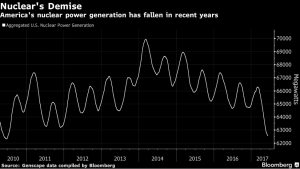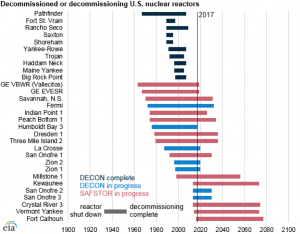Since 2012, carbon dioxide emissions from the electric power sector declined by 10.5 percent, but those emissions reductions could be obliterated if uneconomic nuclear plants are shuttered, according to Bloomberg New Energy Finance. Bloomberg considers 34 of the nation’s 61 plants to be uneconomic because on average it costs $35 a megawatt hour to operate a nuclear plant,[i] while they are getting paid only $20 to $30 a megawatt-hour for their electricity. Almost all of the merchant reactors owned by Exelon Corp., Entergy Corp. and FirstEnergy Corp. are below the break-even point. The losses total about $2.9 billion a year. Merchant nuclear generators selling power into wholesale markets face “financial challenges due to sustained wholesale power price declines and other unfavorable market conditions.”[ii]
Nuclear power plants provide over 55 percent of our carbon-free electricity.[iii] But, due to onerous regulation by the federal government, their total generating costs have increased by over 25 percent since 2002, from $28.27 per megawatt hour to $35.50 per megawatt hour, as described in this IER article.[iv]
Source: Bloomberg
The United States could learn from Germany’s experience. Germany is facing increasing carbon dioxide emissions as it is shuttering its nuclear power plants and replacing them with intermittent renewable technologies (wind and solar) and using coal to back-up the intermittent plants. As a result, its carbon dioxide emissions increased over the past two years.[v] Germany probably cannot meet either its 2020 or its 2030 emissions targets. That is, Germany cannot decrease its carbon dioxide emissions enough in the next two years to reduce its carbon output by 40 percent (compared to its 1990 levels) or 55 percent by 2030. According to the BP Statistical Review, Germany has reduced its carbon dioxide emissions by just 24 percent since 1990 in part to protect 20,000 lignite coal-mining jobs in the eastern part of the country.[vi]
Decommissioning Nuclear Power Plants
According to the Energy Information Administration (EIA), six commercial nuclear reactors in the United States have shuttered since 2013, and an additional eight reactors have announced plans to retire by 2025. As of 2017, 10 commercial nuclear reactors in the United States have been decommissioned, and another 20 U.S. nuclear reactors are currently in different stages of decommissioning. (See chart below.) Decommissioning is a long, expensive and tedious process.[vii]
Source: EIA
To decommission a nuclear power plant, the facility must be deconstructed and the site returned to Greenfield status so that it can be used for other purposes such as housing, farming or industrial use. Onsite nuclear waste must be safely disposed and radioactive material, including nuclear fuel as well as irradiated equipment and buildings, must be removed.
One of two methods can be used to decommission a nuclear plant: decontamination (DECON) or safe storage (SAFSTOR). DECON, the faster method, takes at least seven years and involves removing the fuel and equipment for separate storage and decontamination. SAFSTOR, or deferred dismantling, involves containing and monitoring the reactor and equipment until radiation drops to safe levels, taking up to 50 years for containment followed by up to 10 years for decontamination. The long time period allows some radioactive contamination to decay, reducing the amount of radioactive material that must be disposed of and reducing the cost of decommissioning. The Nuclear Regulatory Commission (NRC) determines when the decommissioning process has been completed and requires a final radiation survey of the site.
The decommissioning process is paid for through a fund that is created during plant construction. About two-thirds of the estimated cost for decommissioning all nuclear reactors in the United States has already been collected. But, additional expenses accrue when reactors are prematurely retired, increasing electric costs for ratepayers.
Some examples of decommissioning costs are: the 619 megawatt Haddam Neck plant in Connecticut, which was shuttered in 1997 and completely decommissioned in 2007 using the DECON method at a cost of $893 million; and the 556 megawatt Kewaunee Nuclear Power Plant in Wisconsin, which was shuttered in 2013 and is being decommissioned using the SAFSTOR method at an estimated cost of almost $1 billion with an expected completion date of 2073.
Conclusion
Nuclear power plants are providing over 55 percent of the carbon-free electricity in the United States, but many of these nuclear plants are having trouble competing as merchant plants in deregulated electricity markets due to onerous regulations imposed by the NRC. As a result, the headway the United States made in reducing carbon dioxide emissions may disappear as more nuclear power plants are shuttered, despite the building of wind and solar plants that operate at less than half the capacity factor of typical nuclear power plants. Finally, decommissioning nuclear plants prematurely can add to ratepayer bills if the full costs of decommissioning have not been collected.
[i] Nuclear Energy Institute, Nuclear Costs in Context, April 2016, http://studylib.net/doc/18310297/nuclear-costs-in-context—nuclear-energy-institute
[ii] Bloomberg, More Than Half of America’s Nuclear Reactors Are Losing Money, June 14, 2017, https://www.bloomberg.com/news/articles/2017-06-14/half-of-america-s-nuclear-power-plants-seen-as-money-losers
[iii] Energy Information Administration, Monthly Energy Review, Table 7.2a, https://www.eia.gov/totalenergy/data/monthly/pdf/sec7_5.pdf
[iv] Institute for Energy Research, Book Review: “Keeping the Lights on at America’s Nuclear Power Plants”, August 7, 2017, https://instituteforenergyresearch.org/analysis/book-review-keeping-lights-americas-nuclear-power-plants/
[v] BP Statistical Review of World Energy 2017, https://www.bp.com/en/global/corporate/energy-economics/statistical-review-of-world-energy/downloads.html
[vi] Foreign Policy, Germany Is a Coal-Burning, Gas-Guzzling Climate Change Hypocrite, November 13, 2017, http://foreignpolicy.com/2017/11/13/germany-is-a-coal-burning-gas-guzzling-climate-change-hypocrite/
[vii] Energy Information Administration, Decommissioning nuclear reactors is a long-term and costly process, November 17, 2017, https://www.eia.gov/todayinenergy/detail.php?id=33792#





